The Role of Dopamine in Schizophrenia
VerifiedAdded on 2023/06/11
|11
|2827
|457
AI Summary
This essay explores the role of dopamine in schizophrenia and its impact on the symptoms of the disease. It discusses the dopamine hypothesis of schizophrenia and the evidence supporting it. It also covers the first and second generation neuroleptics and their mechanism of action.
Contribute Materials
Your contribution can guide someone’s learning journey. Share your
documents today.
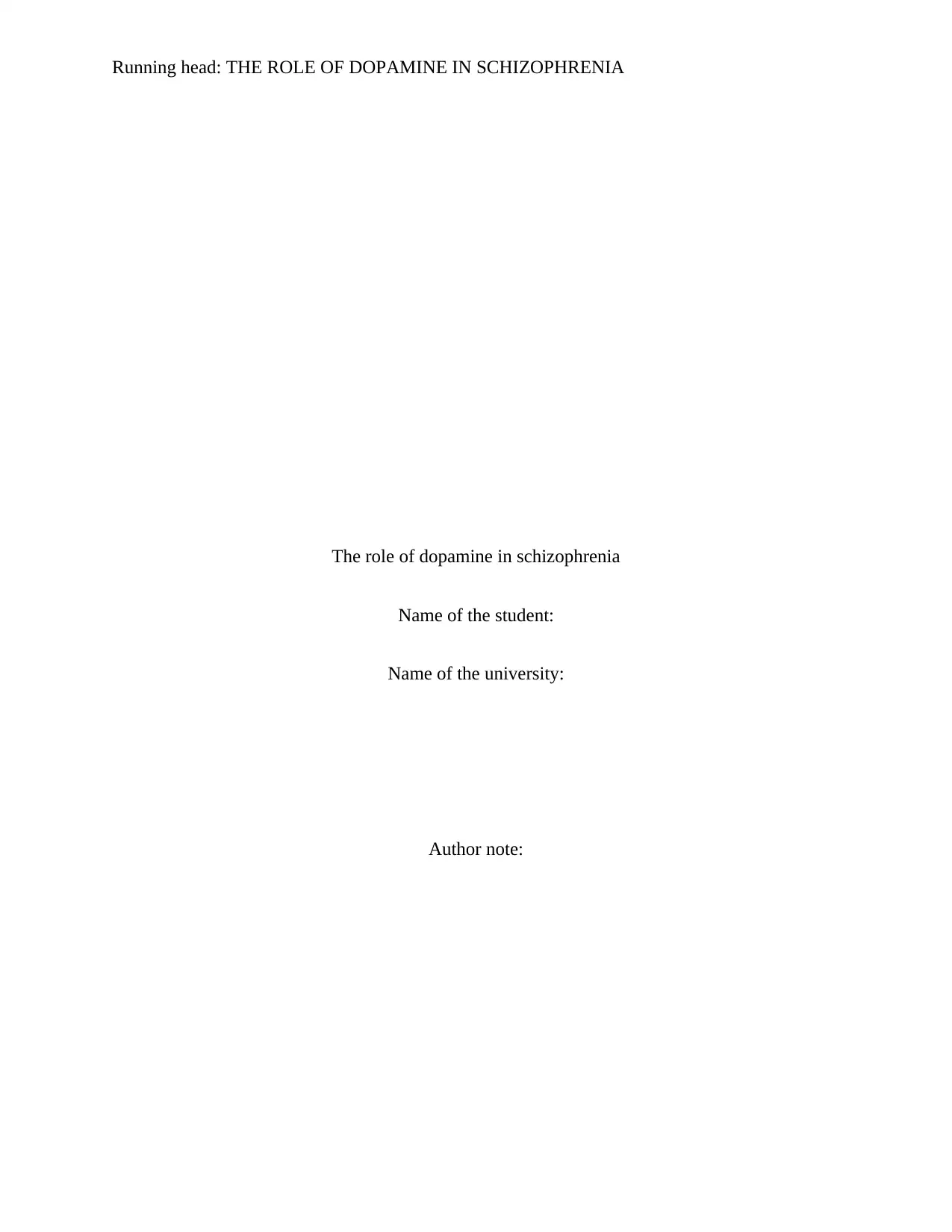
Running head: THE ROLE OF DOPAMINE IN SCHIZOPHRENIA
The role of dopamine in schizophrenia
Name of the student:
Name of the university:
Author note:
The role of dopamine in schizophrenia
Name of the student:
Name of the university:
Author note:
Secure Best Marks with AI Grader
Need help grading? Try our AI Grader for instant feedback on your assignments.

1THE ROLE OF DOPAMINE IN SCHIZOPHRENIA
Schizophrenia can be defined as the long term mental disorder that involves the
breakdown in the relation between the thoughts, emotions, and behavior of an individual that
results into a faulty perception, inappropriate actions and feelings, withdrawal from the reality
and personal relationships that leads onto fantasy and delusions leading to a state of mental;
fragmentation in the individual. The pathology of the diseases is intricately associated with the
inhibitory transmitter called the dopamine. There is a abundantly utilized hypothesis called the
dopamine hypothesis of Schizophrenia that serves as the model for understanding and evaluating
the symptoms of the diseases with accordance to the disturbed and hyperactive dopaminergic
signal transduction procedure (Howes, McCutcheon & Stone, 2015). This model has been
constructed on the basis of the evidence that the most of the antipsychotic medication has a
significant dopamine receptor antagonistic effect.
Although, researchers are of the opinion, that the theory does not give the idea that the
schizophrenic effect is not completely facilitated by the dopamine overabundance. Rather the
theory states the fact that the over-activation of the D2 receptor leads directly to the global
chemical synaptic dys-regulation in the individual which is a characteristic part of the pathology
observed in the patients suffering with this particular disorder. According to the Brisch et al.
(2014), the revised dopamine hypothesis states the fact that dopamine abnormalities has been
observed to be occurring in the mesolimbic and prefrontal brain regions of a patient suffering
with schiozophrenia. This paper will attempt to discuss the pathology of schizophrenia
symptoms favoring the dopamine hypothesis with respect to the effects of the first generation
neuro-leptics and the effects of the second generation neuroleptics in the procedure.
Dopamine can be defined as the neurotransmitter that belongs to the catecholamine
family and is produced in the substantia nigra and the ventral tegmental regions of the brain. It
Schizophrenia can be defined as the long term mental disorder that involves the
breakdown in the relation between the thoughts, emotions, and behavior of an individual that
results into a faulty perception, inappropriate actions and feelings, withdrawal from the reality
and personal relationships that leads onto fantasy and delusions leading to a state of mental;
fragmentation in the individual. The pathology of the diseases is intricately associated with the
inhibitory transmitter called the dopamine. There is a abundantly utilized hypothesis called the
dopamine hypothesis of Schizophrenia that serves as the model for understanding and evaluating
the symptoms of the diseases with accordance to the disturbed and hyperactive dopaminergic
signal transduction procedure (Howes, McCutcheon & Stone, 2015). This model has been
constructed on the basis of the evidence that the most of the antipsychotic medication has a
significant dopamine receptor antagonistic effect.
Although, researchers are of the opinion, that the theory does not give the idea that the
schizophrenic effect is not completely facilitated by the dopamine overabundance. Rather the
theory states the fact that the over-activation of the D2 receptor leads directly to the global
chemical synaptic dys-regulation in the individual which is a characteristic part of the pathology
observed in the patients suffering with this particular disorder. According to the Brisch et al.
(2014), the revised dopamine hypothesis states the fact that dopamine abnormalities has been
observed to be occurring in the mesolimbic and prefrontal brain regions of a patient suffering
with schiozophrenia. This paper will attempt to discuss the pathology of schizophrenia
symptoms favoring the dopamine hypothesis with respect to the effects of the first generation
neuro-leptics and the effects of the second generation neuroleptics in the procedure.
Dopamine can be defined as the neurotransmitter that belongs to the catecholamine
family and is produced in the substantia nigra and the ventral tegmental regions of the brain. It
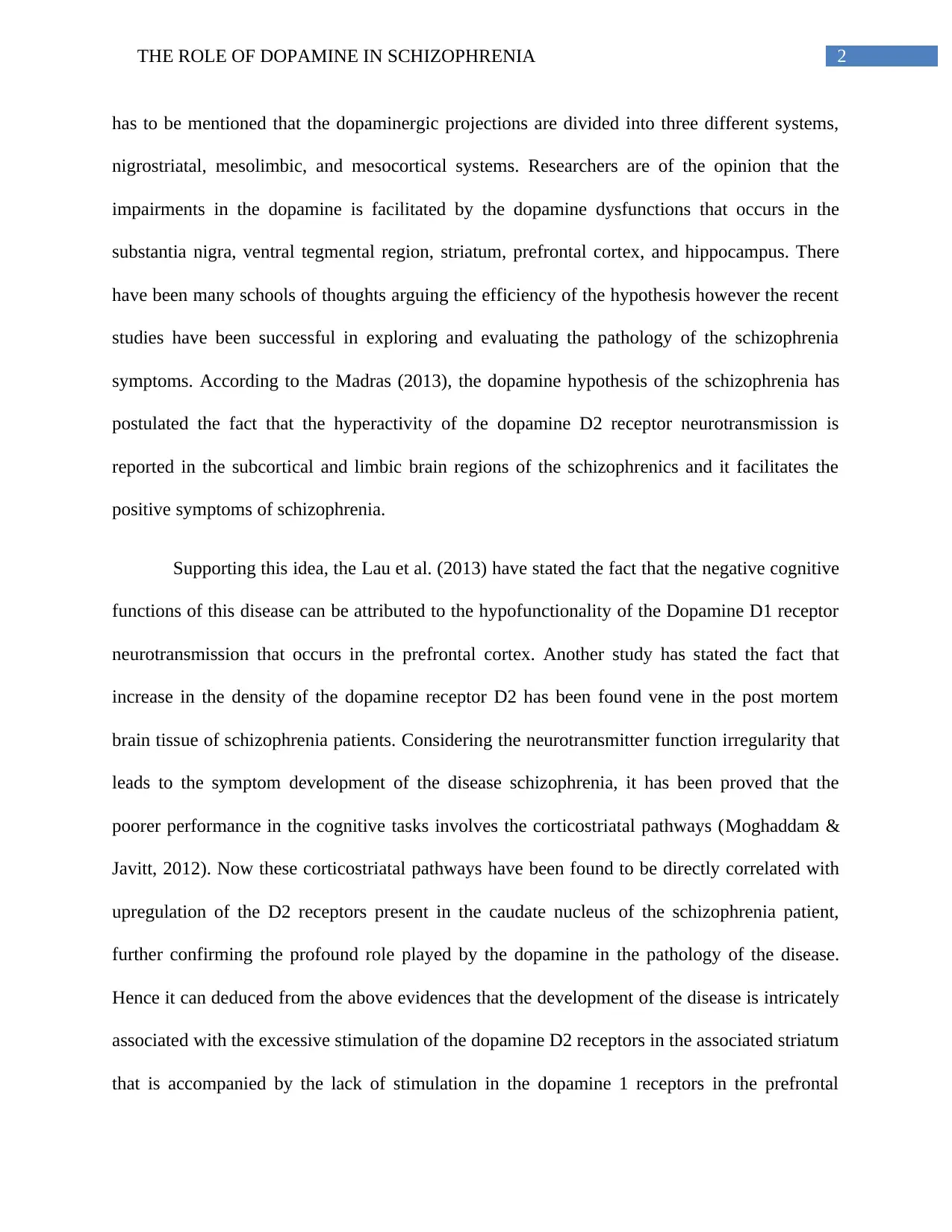
2THE ROLE OF DOPAMINE IN SCHIZOPHRENIA
has to be mentioned that the dopaminergic projections are divided into three different systems,
nigrostriatal, mesolimbic, and mesocortical systems. Researchers are of the opinion that the
impairments in the dopamine is facilitated by the dopamine dysfunctions that occurs in the
substantia nigra, ventral tegmental region, striatum, prefrontal cortex, and hippocampus. There
have been many schools of thoughts arguing the efficiency of the hypothesis however the recent
studies have been successful in exploring and evaluating the pathology of the schizophrenia
symptoms. According to the Madras (2013), the dopamine hypothesis of the schizophrenia has
postulated the fact that the hyperactivity of the dopamine D2 receptor neurotransmission is
reported in the subcortical and limbic brain regions of the schizophrenics and it facilitates the
positive symptoms of schizophrenia.
Supporting this idea, the Lau et al. (2013) have stated the fact that the negative cognitive
functions of this disease can be attributed to the hypofunctionality of the Dopamine D1 receptor
neurotransmission that occurs in the prefrontal cortex. Another study has stated the fact that
increase in the density of the dopamine receptor D2 has been found vene in the post mortem
brain tissue of schizophrenia patients. Considering the neurotransmitter function irregularity that
leads to the symptom development of the disease schizophrenia, it has been proved that the
poorer performance in the cognitive tasks involves the corticostriatal pathways (Moghaddam &
Javitt, 2012). Now these corticostriatal pathways have been found to be directly correlated with
upregulation of the D2 receptors present in the caudate nucleus of the schizophrenia patient,
further confirming the profound role played by the dopamine in the pathology of the disease.
Hence it can deduced from the above evidences that the development of the disease is intricately
associated with the excessive stimulation of the dopamine D2 receptors in the associated striatum
that is accompanied by the lack of stimulation in the dopamine 1 receptors in the prefrontal
has to be mentioned that the dopaminergic projections are divided into three different systems,
nigrostriatal, mesolimbic, and mesocortical systems. Researchers are of the opinion that the
impairments in the dopamine is facilitated by the dopamine dysfunctions that occurs in the
substantia nigra, ventral tegmental region, striatum, prefrontal cortex, and hippocampus. There
have been many schools of thoughts arguing the efficiency of the hypothesis however the recent
studies have been successful in exploring and evaluating the pathology of the schizophrenia
symptoms. According to the Madras (2013), the dopamine hypothesis of the schizophrenia has
postulated the fact that the hyperactivity of the dopamine D2 receptor neurotransmission is
reported in the subcortical and limbic brain regions of the schizophrenics and it facilitates the
positive symptoms of schizophrenia.
Supporting this idea, the Lau et al. (2013) have stated the fact that the negative cognitive
functions of this disease can be attributed to the hypofunctionality of the Dopamine D1 receptor
neurotransmission that occurs in the prefrontal cortex. Another study has stated the fact that
increase in the density of the dopamine receptor D2 has been found vene in the post mortem
brain tissue of schizophrenia patients. Considering the neurotransmitter function irregularity that
leads to the symptom development of the disease schizophrenia, it has been proved that the
poorer performance in the cognitive tasks involves the corticostriatal pathways (Moghaddam &
Javitt, 2012). Now these corticostriatal pathways have been found to be directly correlated with
upregulation of the D2 receptors present in the caudate nucleus of the schizophrenia patient,
further confirming the profound role played by the dopamine in the pathology of the disease.
Hence it can deduced from the above evidences that the development of the disease is intricately
associated with the excessive stimulation of the dopamine D2 receptors in the associated striatum
that is accompanied by the lack of stimulation in the dopamine 1 receptors in the prefrontal
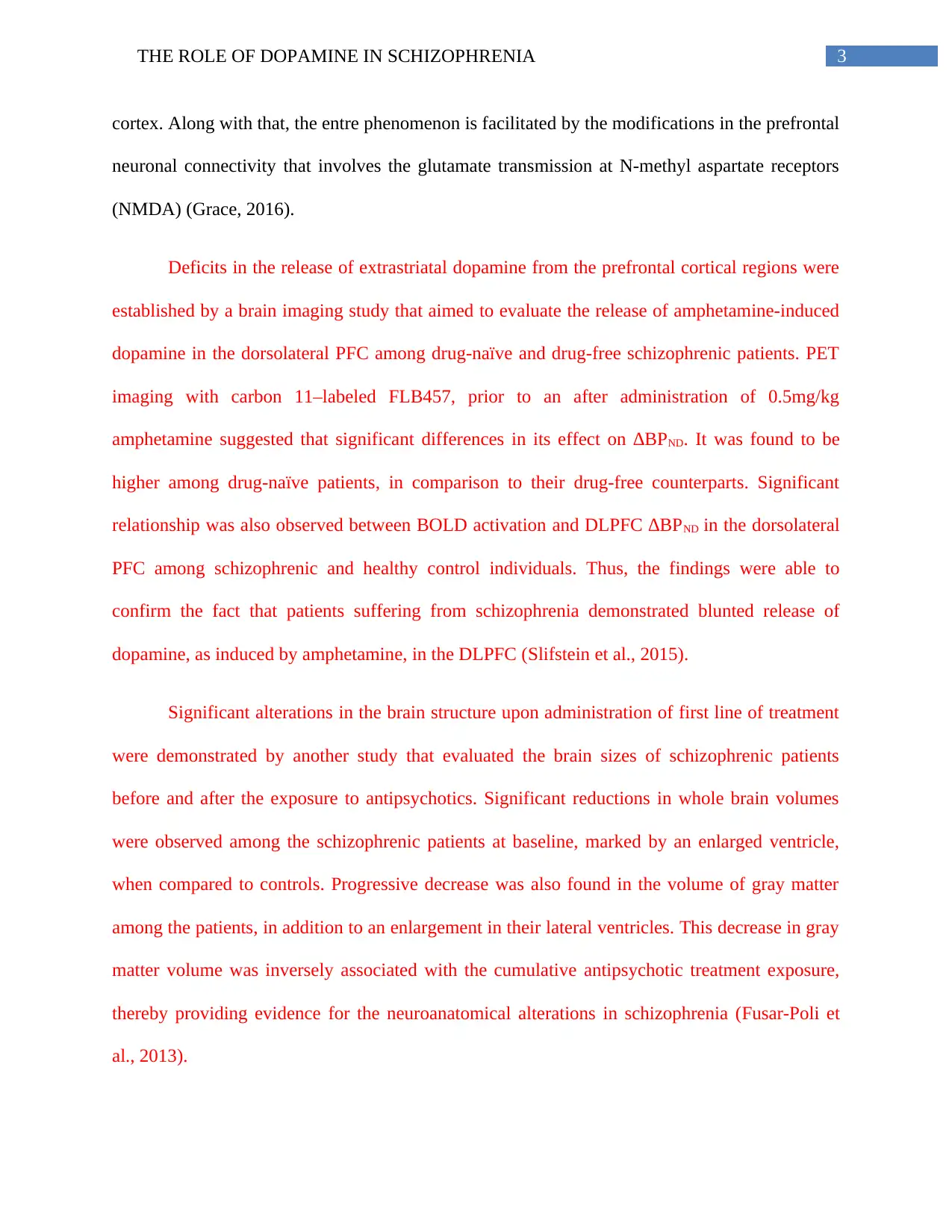
3THE ROLE OF DOPAMINE IN SCHIZOPHRENIA
cortex. Along with that, the entre phenomenon is facilitated by the modifications in the prefrontal
neuronal connectivity that involves the glutamate transmission at N-methyl aspartate receptors
(NMDA) (Grace, 2016).
Deficits in the release of extrastriatal dopamine from the prefrontal cortical regions were
established by a brain imaging study that aimed to evaluate the release of amphetamine-induced
dopamine in the dorsolateral PFC among drug-naïve and drug-free schizophrenic patients. PET
imaging with carbon 11–labeled FLB457, prior to an after administration of 0.5mg/kg
amphetamine suggested that significant differences in its effect on ∆BPND. It was found to be
higher among drug-naïve patients, in comparison to their drug-free counterparts. Significant
relationship was also observed between BOLD activation and DLPFC ∆BPND in the dorsolateral
PFC among schizophrenic and healthy control individuals. Thus, the findings were able to
confirm the fact that patients suffering from schizophrenia demonstrated blunted release of
dopamine, as induced by amphetamine, in the DLPFC (Slifstein et al., 2015).
Significant alterations in the brain structure upon administration of first line of treatment
were demonstrated by another study that evaluated the brain sizes of schizophrenic patients
before and after the exposure to antipsychotics. Significant reductions in whole brain volumes
were observed among the schizophrenic patients at baseline, marked by an enlarged ventricle,
when compared to controls. Progressive decrease was also found in the volume of gray matter
among the patients, in addition to an enlargement in their lateral ventricles. This decrease in gray
matter volume was inversely associated with the cumulative antipsychotic treatment exposure,
thereby providing evidence for the neuroanatomical alterations in schizophrenia (Fusar-Poli et
al., 2013).
cortex. Along with that, the entre phenomenon is facilitated by the modifications in the prefrontal
neuronal connectivity that involves the glutamate transmission at N-methyl aspartate receptors
(NMDA) (Grace, 2016).
Deficits in the release of extrastriatal dopamine from the prefrontal cortical regions were
established by a brain imaging study that aimed to evaluate the release of amphetamine-induced
dopamine in the dorsolateral PFC among drug-naïve and drug-free schizophrenic patients. PET
imaging with carbon 11–labeled FLB457, prior to an after administration of 0.5mg/kg
amphetamine suggested that significant differences in its effect on ∆BPND. It was found to be
higher among drug-naïve patients, in comparison to their drug-free counterparts. Significant
relationship was also observed between BOLD activation and DLPFC ∆BPND in the dorsolateral
PFC among schizophrenic and healthy control individuals. Thus, the findings were able to
confirm the fact that patients suffering from schizophrenia demonstrated blunted release of
dopamine, as induced by amphetamine, in the DLPFC (Slifstein et al., 2015).
Significant alterations in the brain structure upon administration of first line of treatment
were demonstrated by another study that evaluated the brain sizes of schizophrenic patients
before and after the exposure to antipsychotics. Significant reductions in whole brain volumes
were observed among the schizophrenic patients at baseline, marked by an enlarged ventricle,
when compared to controls. Progressive decrease was also found in the volume of gray matter
among the patients, in addition to an enlargement in their lateral ventricles. This decrease in gray
matter volume was inversely associated with the cumulative antipsychotic treatment exposure,
thereby providing evidence for the neuroanatomical alterations in schizophrenia (Fusar-Poli et
al., 2013).
Secure Best Marks with AI Grader
Need help grading? Try our AI Grader for instant feedback on your assignments.
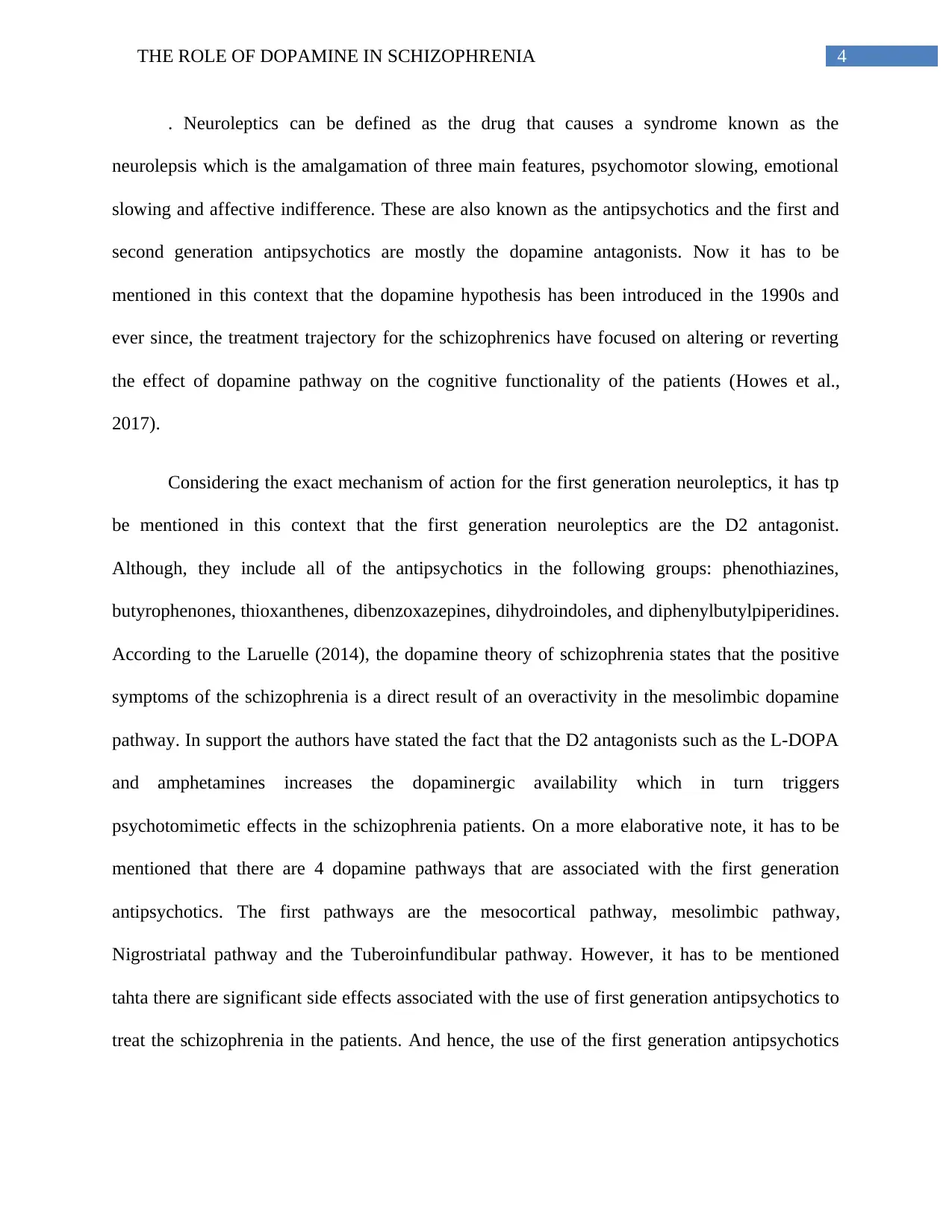
4THE ROLE OF DOPAMINE IN SCHIZOPHRENIA
. Neuroleptics can be defined as the drug that causes a syndrome known as the
neurolepsis which is the amalgamation of three main features, psychomotor slowing, emotional
slowing and affective indifference. These are also known as the antipsychotics and the first and
second generation antipsychotics are mostly the dopamine antagonists. Now it has to be
mentioned in this context that the dopamine hypothesis has been introduced in the 1990s and
ever since, the treatment trajectory for the schizophrenics have focused on altering or reverting
the effect of dopamine pathway on the cognitive functionality of the patients (Howes et al.,
2017).
Considering the exact mechanism of action for the first generation neuroleptics, it has tp
be mentioned in this context that the first generation neuroleptics are the D2 antagonist.
Although, they include all of the antipsychotics in the following groups: phenothiazines,
butyrophenones, thioxanthenes, dibenzoxazepines, dihydroindoles, and diphenylbutylpiperidines.
According to the Laruelle (2014), the dopamine theory of schizophrenia states that the positive
symptoms of the schizophrenia is a direct result of an overactivity in the mesolimbic dopamine
pathway. In support the authors have stated the fact that the D2 antagonists such as the L-DOPA
and amphetamines increases the dopaminergic availability which in turn triggers
psychotomimetic effects in the schizophrenia patients. On a more elaborative note, it has to be
mentioned that there are 4 dopamine pathways that are associated with the first generation
antipsychotics. The first pathways are the mesocortical pathway, mesolimbic pathway,
Nigrostriatal pathway and the Tuberoinfundibular pathway. However, it has to be mentioned
tahta there are significant side effects associated with the use of first generation antipsychotics to
treat the schizophrenia in the patients. And hence, the use of the first generation antipsychotics
. Neuroleptics can be defined as the drug that causes a syndrome known as the
neurolepsis which is the amalgamation of three main features, psychomotor slowing, emotional
slowing and affective indifference. These are also known as the antipsychotics and the first and
second generation antipsychotics are mostly the dopamine antagonists. Now it has to be
mentioned in this context that the dopamine hypothesis has been introduced in the 1990s and
ever since, the treatment trajectory for the schizophrenics have focused on altering or reverting
the effect of dopamine pathway on the cognitive functionality of the patients (Howes et al.,
2017).
Considering the exact mechanism of action for the first generation neuroleptics, it has tp
be mentioned in this context that the first generation neuroleptics are the D2 antagonist.
Although, they include all of the antipsychotics in the following groups: phenothiazines,
butyrophenones, thioxanthenes, dibenzoxazepines, dihydroindoles, and diphenylbutylpiperidines.
According to the Laruelle (2014), the dopamine theory of schizophrenia states that the positive
symptoms of the schizophrenia is a direct result of an overactivity in the mesolimbic dopamine
pathway. In support the authors have stated the fact that the D2 antagonists such as the L-DOPA
and amphetamines increases the dopaminergic availability which in turn triggers
psychotomimetic effects in the schizophrenia patients. On a more elaborative note, it has to be
mentioned that there are 4 dopamine pathways that are associated with the first generation
antipsychotics. The first pathways are the mesocortical pathway, mesolimbic pathway,
Nigrostriatal pathway and the Tuberoinfundibular pathway. However, it has to be mentioned
tahta there are significant side effects associated with the use of first generation antipsychotics to
treat the schizophrenia in the patients. And hence, the use of the first generation antipsychotics
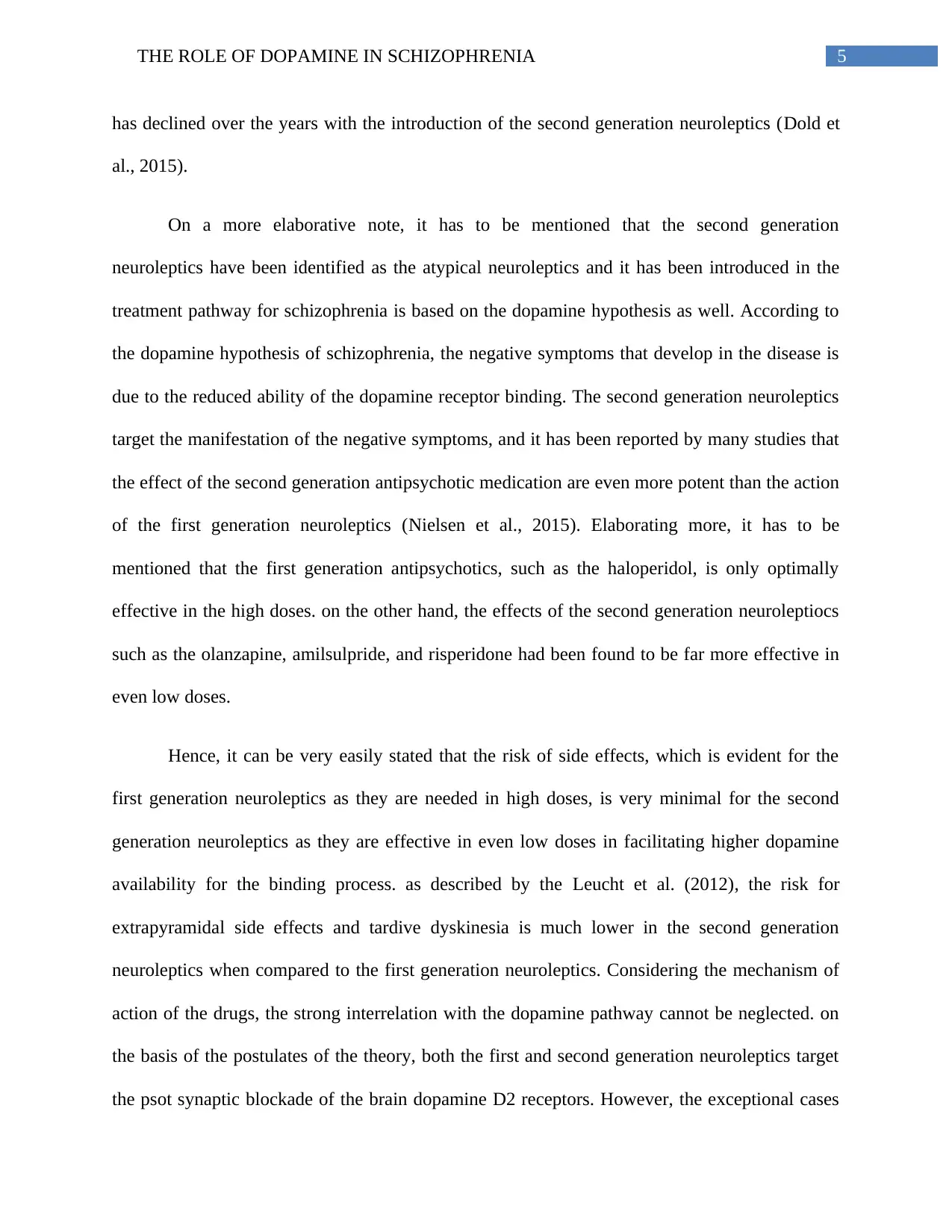
5THE ROLE OF DOPAMINE IN SCHIZOPHRENIA
has declined over the years with the introduction of the second generation neuroleptics (Dold et
al., 2015).
On a more elaborative note, it has to be mentioned that the second generation
neuroleptics have been identified as the atypical neuroleptics and it has been introduced in the
treatment pathway for schizophrenia is based on the dopamine hypothesis as well. According to
the dopamine hypothesis of schizophrenia, the negative symptoms that develop in the disease is
due to the reduced ability of the dopamine receptor binding. The second generation neuroleptics
target the manifestation of the negative symptoms, and it has been reported by many studies that
the effect of the second generation antipsychotic medication are even more potent than the action
of the first generation neuroleptics (Nielsen et al., 2015). Elaborating more, it has to be
mentioned that the first generation antipsychotics, such as the haloperidol, is only optimally
effective in the high doses. on the other hand, the effects of the second generation neuroleptiocs
such as the olanzapine, amilsulpride, and risperidone had been found to be far more effective in
even low doses.
Hence, it can be very easily stated that the risk of side effects, which is evident for the
first generation neuroleptics as they are needed in high doses, is very minimal for the second
generation neuroleptics as they are effective in even low doses in facilitating higher dopamine
availability for the binding process. as described by the Leucht et al. (2012), the risk for
extrapyramidal side effects and tardive dyskinesia is much lower in the second generation
neuroleptics when compared to the first generation neuroleptics. Considering the mechanism of
action of the drugs, the strong interrelation with the dopamine pathway cannot be neglected. on
the basis of the postulates of the theory, both the first and second generation neuroleptics target
the psot synaptic blockade of the brain dopamine D2 receptors. However, the exceptional cases
has declined over the years with the introduction of the second generation neuroleptics (Dold et
al., 2015).
On a more elaborative note, it has to be mentioned that the second generation
neuroleptics have been identified as the atypical neuroleptics and it has been introduced in the
treatment pathway for schizophrenia is based on the dopamine hypothesis as well. According to
the dopamine hypothesis of schizophrenia, the negative symptoms that develop in the disease is
due to the reduced ability of the dopamine receptor binding. The second generation neuroleptics
target the manifestation of the negative symptoms, and it has been reported by many studies that
the effect of the second generation antipsychotic medication are even more potent than the action
of the first generation neuroleptics (Nielsen et al., 2015). Elaborating more, it has to be
mentioned that the first generation antipsychotics, such as the haloperidol, is only optimally
effective in the high doses. on the other hand, the effects of the second generation neuroleptiocs
such as the olanzapine, amilsulpride, and risperidone had been found to be far more effective in
even low doses.
Hence, it can be very easily stated that the risk of side effects, which is evident for the
first generation neuroleptics as they are needed in high doses, is very minimal for the second
generation neuroleptics as they are effective in even low doses in facilitating higher dopamine
availability for the binding process. as described by the Leucht et al. (2012), the risk for
extrapyramidal side effects and tardive dyskinesia is much lower in the second generation
neuroleptics when compared to the first generation neuroleptics. Considering the mechanism of
action of the drugs, the strong interrelation with the dopamine pathway cannot be neglected. on
the basis of the postulates of the theory, both the first and second generation neuroleptics target
the psot synaptic blockade of the brain dopamine D2 receptors. However, the exceptional cases
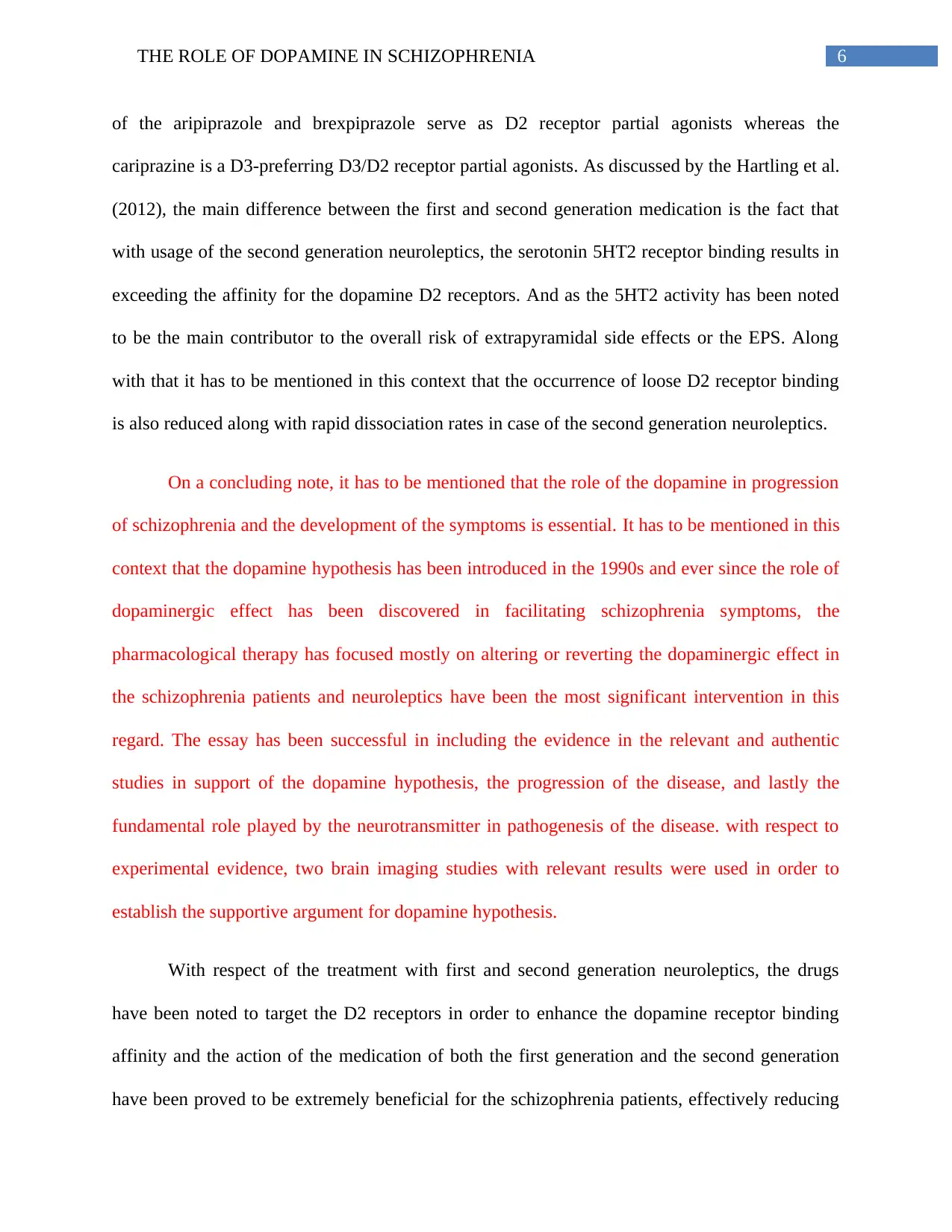
6THE ROLE OF DOPAMINE IN SCHIZOPHRENIA
of the aripiprazole and brexpiprazole serve as D2 receptor partial agonists whereas the
cariprazine is a D3-preferring D3/D2 receptor partial agonists. As discussed by the Hartling et al.
(2012), the main difference between the first and second generation medication is the fact that
with usage of the second generation neuroleptics, the serotonin 5HT2 receptor binding results in
exceeding the affinity for the dopamine D2 receptors. And as the 5HT2 activity has been noted
to be the main contributor to the overall risk of extrapyramidal side effects or the EPS. Along
with that it has to be mentioned in this context that the occurrence of loose D2 receptor binding
is also reduced along with rapid dissociation rates in case of the second generation neuroleptics.
On a concluding note, it has to be mentioned that the role of the dopamine in progression
of schizophrenia and the development of the symptoms is essential. It has to be mentioned in this
context that the dopamine hypothesis has been introduced in the 1990s and ever since the role of
dopaminergic effect has been discovered in facilitating schizophrenia symptoms, the
pharmacological therapy has focused mostly on altering or reverting the dopaminergic effect in
the schizophrenia patients and neuroleptics have been the most significant intervention in this
regard. The essay has been successful in including the evidence in the relevant and authentic
studies in support of the dopamine hypothesis, the progression of the disease, and lastly the
fundamental role played by the neurotransmitter in pathogenesis of the disease. with respect to
experimental evidence, two brain imaging studies with relevant results were used in order to
establish the supportive argument for dopamine hypothesis.
With respect of the treatment with first and second generation neuroleptics, the drugs
have been noted to target the D2 receptors in order to enhance the dopamine receptor binding
affinity and the action of the medication of both the first generation and the second generation
have been proved to be extremely beneficial for the schizophrenia patients, effectively reducing
of the aripiprazole and brexpiprazole serve as D2 receptor partial agonists whereas the
cariprazine is a D3-preferring D3/D2 receptor partial agonists. As discussed by the Hartling et al.
(2012), the main difference between the first and second generation medication is the fact that
with usage of the second generation neuroleptics, the serotonin 5HT2 receptor binding results in
exceeding the affinity for the dopamine D2 receptors. And as the 5HT2 activity has been noted
to be the main contributor to the overall risk of extrapyramidal side effects or the EPS. Along
with that it has to be mentioned in this context that the occurrence of loose D2 receptor binding
is also reduced along with rapid dissociation rates in case of the second generation neuroleptics.
On a concluding note, it has to be mentioned that the role of the dopamine in progression
of schizophrenia and the development of the symptoms is essential. It has to be mentioned in this
context that the dopamine hypothesis has been introduced in the 1990s and ever since the role of
dopaminergic effect has been discovered in facilitating schizophrenia symptoms, the
pharmacological therapy has focused mostly on altering or reverting the dopaminergic effect in
the schizophrenia patients and neuroleptics have been the most significant intervention in this
regard. The essay has been successful in including the evidence in the relevant and authentic
studies in support of the dopamine hypothesis, the progression of the disease, and lastly the
fundamental role played by the neurotransmitter in pathogenesis of the disease. with respect to
experimental evidence, two brain imaging studies with relevant results were used in order to
establish the supportive argument for dopamine hypothesis.
With respect of the treatment with first and second generation neuroleptics, the drugs
have been noted to target the D2 receptors in order to enhance the dopamine receptor binding
affinity and the action of the medication of both the first generation and the second generation
have been proved to be extremely beneficial for the schizophrenia patients, effectively reducing
Paraphrase This Document
Need a fresh take? Get an instant paraphrase of this document with our AI Paraphraser
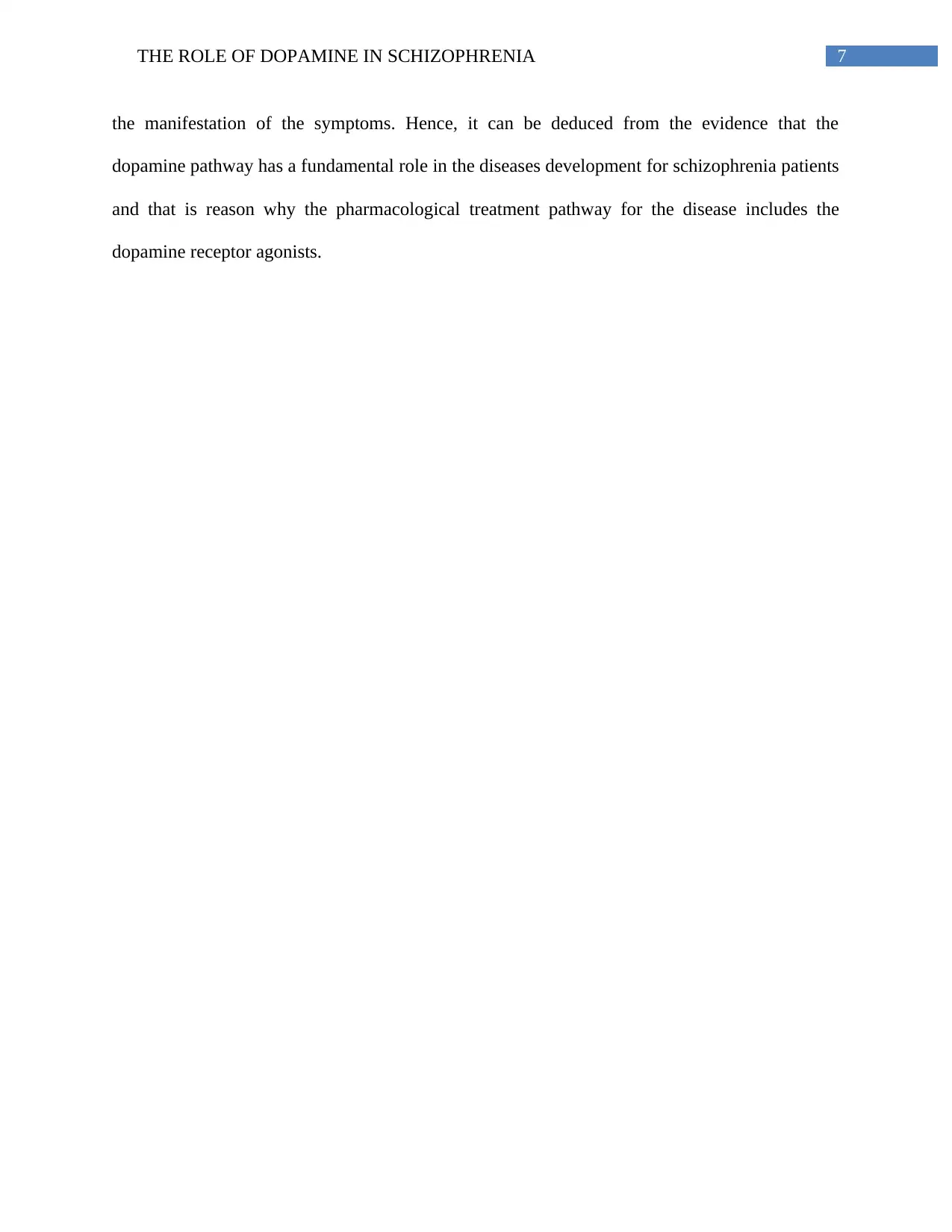
7THE ROLE OF DOPAMINE IN SCHIZOPHRENIA
the manifestation of the symptoms. Hence, it can be deduced from the evidence that the
dopamine pathway has a fundamental role in the diseases development for schizophrenia patients
and that is reason why the pharmacological treatment pathway for the disease includes the
dopamine receptor agonists.
the manifestation of the symptoms. Hence, it can be deduced from the evidence that the
dopamine pathway has a fundamental role in the diseases development for schizophrenia patients
and that is reason why the pharmacological treatment pathway for the disease includes the
dopamine receptor agonists.

8THE ROLE OF DOPAMINE IN SCHIZOPHRENIA
References:
Brisch, R., Saniotis, A., Wolf, R., Bielau, H., Bernstein, H. G., Steiner, J., ... & Henneberg, M.
(2014). The role of dopamine in schizophrenia from a neurobiological and evolutionary
perspective: old fashioned, but still in vogue. Frontiers in psychiatry, 5, 47.
Dold, M., Samara, M. T., Li, C., Tardy, M., & Leucht, S. (2015). Haloperidol versus first‐
generation antipsychotics for the treatment of schizophrenia and other psychotic
disorders. The Cochrane Library.
Fusar-Poli, P., Smieskova, R., Kempton, M. J., Ho, B. C., Andreasen, N. C., & Borgwardt, S.
(2013). Progressive brain changes in schizophrenia related to antipsychotic treatment? A
meta-analysis of longitudinal MRI studies. Neuroscience & Biobehavioral
Reviews, 37(8), 1680-1691.
Grace, A. A. (2016). Dysregulation of the dopamine system in the pathophysiology of
schizophrenia and depression. Nature Reviews Neuroscience, 17(8), 524.
Hartling, L., Abou-Setta, A. M., Dursun, S., Mousavi, S. S., Pasichnyk, D., & Newton, A. S.
(2012). Antipsychotics in adults with schizophrenia: comparative effectiveness of first-
generation versus second-generation medications: a systematic review and meta-
analysis. Annals of internal medicine, 157(7), 498-511.
Howes, O. D., McCutcheon, R., Owen, M. J., & Murray, R. M. (2017). The role of genes, stress,
and dopamine in the development of schizophrenia. Biological psychiatry, 81(1), 9-20.
References:
Brisch, R., Saniotis, A., Wolf, R., Bielau, H., Bernstein, H. G., Steiner, J., ... & Henneberg, M.
(2014). The role of dopamine in schizophrenia from a neurobiological and evolutionary
perspective: old fashioned, but still in vogue. Frontiers in psychiatry, 5, 47.
Dold, M., Samara, M. T., Li, C., Tardy, M., & Leucht, S. (2015). Haloperidol versus first‐
generation antipsychotics for the treatment of schizophrenia and other psychotic
disorders. The Cochrane Library.
Fusar-Poli, P., Smieskova, R., Kempton, M. J., Ho, B. C., Andreasen, N. C., & Borgwardt, S.
(2013). Progressive brain changes in schizophrenia related to antipsychotic treatment? A
meta-analysis of longitudinal MRI studies. Neuroscience & Biobehavioral
Reviews, 37(8), 1680-1691.
Grace, A. A. (2016). Dysregulation of the dopamine system in the pathophysiology of
schizophrenia and depression. Nature Reviews Neuroscience, 17(8), 524.
Hartling, L., Abou-Setta, A. M., Dursun, S., Mousavi, S. S., Pasichnyk, D., & Newton, A. S.
(2012). Antipsychotics in adults with schizophrenia: comparative effectiveness of first-
generation versus second-generation medications: a systematic review and meta-
analysis. Annals of internal medicine, 157(7), 498-511.
Howes, O. D., McCutcheon, R., Owen, M. J., & Murray, R. M. (2017). The role of genes, stress,
and dopamine in the development of schizophrenia. Biological psychiatry, 81(1), 9-20.
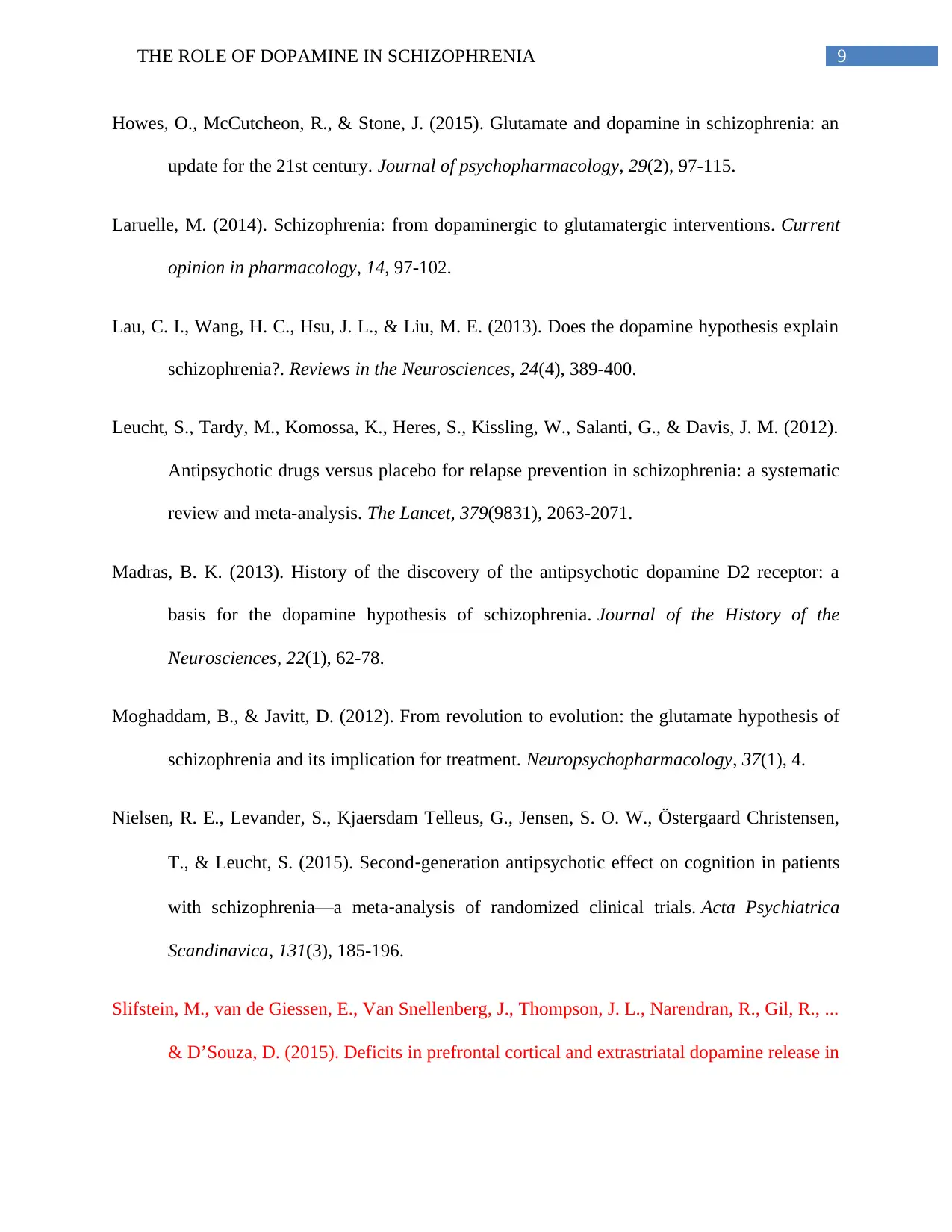
9THE ROLE OF DOPAMINE IN SCHIZOPHRENIA
Howes, O., McCutcheon, R., & Stone, J. (2015). Glutamate and dopamine in schizophrenia: an
update for the 21st century. Journal of psychopharmacology, 29(2), 97-115.
Laruelle, M. (2014). Schizophrenia: from dopaminergic to glutamatergic interventions. Current
opinion in pharmacology, 14, 97-102.
Lau, C. I., Wang, H. C., Hsu, J. L., & Liu, M. E. (2013). Does the dopamine hypothesis explain
schizophrenia?. Reviews in the Neurosciences, 24(4), 389-400.
Leucht, S., Tardy, M., Komossa, K., Heres, S., Kissling, W., Salanti, G., & Davis, J. M. (2012).
Antipsychotic drugs versus placebo for relapse prevention in schizophrenia: a systematic
review and meta-analysis. The Lancet, 379(9831), 2063-2071.
Madras, B. K. (2013). History of the discovery of the antipsychotic dopamine D2 receptor: a
basis for the dopamine hypothesis of schizophrenia. Journal of the History of the
Neurosciences, 22(1), 62-78.
Moghaddam, B., & Javitt, D. (2012). From revolution to evolution: the glutamate hypothesis of
schizophrenia and its implication for treatment. Neuropsychopharmacology, 37(1), 4.
Nielsen, R. E., Levander, S., Kjaersdam Telleus, G., Jensen, S. O. W., Östergaard Christensen,
T., & Leucht, S. (2015). Second‐generation antipsychotic effect on cognition in patients
with schizophrenia—a meta‐analysis of randomized clinical trials. Acta Psychiatrica
Scandinavica, 131(3), 185-196.
Slifstein, M., van de Giessen, E., Van Snellenberg, J., Thompson, J. L., Narendran, R., Gil, R., ...
& D’Souza, D. (2015). Deficits in prefrontal cortical and extrastriatal dopamine release in
Howes, O., McCutcheon, R., & Stone, J. (2015). Glutamate and dopamine in schizophrenia: an
update for the 21st century. Journal of psychopharmacology, 29(2), 97-115.
Laruelle, M. (2014). Schizophrenia: from dopaminergic to glutamatergic interventions. Current
opinion in pharmacology, 14, 97-102.
Lau, C. I., Wang, H. C., Hsu, J. L., & Liu, M. E. (2013). Does the dopamine hypothesis explain
schizophrenia?. Reviews in the Neurosciences, 24(4), 389-400.
Leucht, S., Tardy, M., Komossa, K., Heres, S., Kissling, W., Salanti, G., & Davis, J. M. (2012).
Antipsychotic drugs versus placebo for relapse prevention in schizophrenia: a systematic
review and meta-analysis. The Lancet, 379(9831), 2063-2071.
Madras, B. K. (2013). History of the discovery of the antipsychotic dopamine D2 receptor: a
basis for the dopamine hypothesis of schizophrenia. Journal of the History of the
Neurosciences, 22(1), 62-78.
Moghaddam, B., & Javitt, D. (2012). From revolution to evolution: the glutamate hypothesis of
schizophrenia and its implication for treatment. Neuropsychopharmacology, 37(1), 4.
Nielsen, R. E., Levander, S., Kjaersdam Telleus, G., Jensen, S. O. W., Östergaard Christensen,
T., & Leucht, S. (2015). Second‐generation antipsychotic effect on cognition in patients
with schizophrenia—a meta‐analysis of randomized clinical trials. Acta Psychiatrica
Scandinavica, 131(3), 185-196.
Slifstein, M., van de Giessen, E., Van Snellenberg, J., Thompson, J. L., Narendran, R., Gil, R., ...
& D’Souza, D. (2015). Deficits in prefrontal cortical and extrastriatal dopamine release in
Secure Best Marks with AI Grader
Need help grading? Try our AI Grader for instant feedback on your assignments.

10THE ROLE OF DOPAMINE IN SCHIZOPHRENIA
schizophrenia: a positron emission tomographic functional magnetic resonance imaging
study. JAMA psychiatry, 72(4), 316-324.
schizophrenia: a positron emission tomographic functional magnetic resonance imaging
study. JAMA psychiatry, 72(4), 316-324.
1 out of 11
Your All-in-One AI-Powered Toolkit for Academic Success.
+13062052269
info@desklib.com
Available 24*7 on WhatsApp / Email
![[object Object]](/_next/static/media/star-bottom.7253800d.svg)
Unlock your academic potential
© 2024 | Zucol Services PVT LTD | All rights reserved.